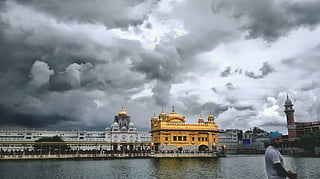- Destinations
- Experiences
- Stay
- What's new
- Editor’s Picks
- Responsible Tourism
- CampaignsCampaigns
- Subscribe

When you think of Amritsar, you will be forgiven for thinking instantly of the Golden Temple, the most famous resident of this beautiful city; however, beyond the golden façade lies a city teeming with hidden gems waiting to be discovered. Here, we set out to discover lesser-known facets of Amritsar, from charming markets brimming with handcrafted items to historical sites that humbly tell tales of bygone times. Let's delve into the enchanting tapestry of Amritsar's best-kept secrets, which promise to unveil a side of the city that is sometimes obscured by the splendour of its iconic centrepiece.
As the sole surviving gateway of the original twelve that once framed the city’s perimeter, Ram Bagh Gate is considered to have served as a connection between the Golden Temple and the Summer Palace, also known as the Ram Bagh Palace. Much like the other twelve, this gate was built to protect the city from external invaders. The gate's interior has been renovated while maintaining the structure's original architectural layout. Inside the gate are the colourful steel trunks that contain the stories of those who fled during the partition of the country in 1947 and also showcase the blend of traditional and modern architecture.
Quila Ahluwalia, an old fort situated in the heart of the old city, is a magnificent example of Punjab's architectural beauty and rich history. The Ahluwalia Misl leader Jassa Singh Ahluwalia constructed the Quila (Fort) as a sanctuary of rest and reflection for himself and his entourage during their travel to Harimandir Sahib, symbolising their might and power. After Jassa Singh's death, his successors assumed control of the fort and expanded it to strengthen its defences. In 1802, the fort was taken over by Maharaja Ranjit Singh Ji, the chief of the Shukarchakiya Misl, who also established cordial ties with Fateh Singh, the chief of the Ahluwalia Misl.
Later, to boost Amritsar's economy, Maharaja Ranjit Singh permitted a large number of Marwari clan merchants and cloth merchants to reside in the fort's surrounding markets. As a result, India's textile market was a huge success, and this decision marked a transformative era in the region's economy, particularly propelling India's textile market to unprecedented heights of success. Quila Ahluwalia is undoubtedly a must-visit destination on your next trip to Amritsar.
Constructed under the patronage of Maharaja Ranjit Singh, the charismatic monarch of the Sikh Empire, Pul Kanjari was not just a monument but a testament to the Maharaja's visionary leadership.
The site served as a stopover for the Maharaja and his royal entourage on their way from Lahore to Amritsar. Pul Kanjari was a major hub for trade in the 18th century. It was named after a small bridge Maharaja Ranjit Singh erected over the canal connecting Amritsar and Lahore in honour of his favourite dancer, Moran, an artiste from the nearby village of Makhanpura.
As part of his secular ideals, the Maharaja built a temple, a gurudwara, a baoli, and a mosque there. Nestled inside the dome on the corner of the Baoli are several scenes and landmarks from the Hindu texts and the Raj Darbar. Floral frames are woven across these murals. This monument is a true reflection of the ruler’s secular ethos and the inclusive spirit of his empire.
Amidst the bustling lanes of Hall Bazaar, in the vibrant heart of the city, stands the Jama Masjid Khairuddin Mosque, a spiritual sanctuary and a beacon of Islamic faith. Even though there are two more mosques nearby, Jama Masjid Khairuddin Mosque is the focal point of all Islamic prayers in the city, drawing the maximum amount of devotees.
Built in 1876 by Mohammad Khairuddin, the mosque is one of the area's most revered places of worship. After the Jallianwala Bagh massacre in 1919, which left the garden littered with blood and dead bodies, this mosque served as the cremation site for those bodies. Muslims carried out the rituals performed at the cremation ceremonies of those bodies.
Today, the Jama Masjid Khairuddin Mosque stands as a poignant reminder of the past, its walls echoing the tales of history, resilience, and unity. It remains a cherished gem of the city, unexplored by many, yet holding stories of faith, hope, and the indomitable human spirit within its precincts.
Renowned for its breathtaking Mughal gates, the Sarai Amanat Khan is an embodiment of architectural excellence. A mosque featuring Arabic calligraphy and its glazed tile architecture. Its two entrances, Lahori Darwaza and Dilli Darwaza, lead to a large courtyard with a mosque and a well. Visiting this area, you might see some of Sarai's Mughal-era artwork. Sarai was the Persian calligrapher Amanat Khan's assistant who inscribed words from the Koran/Quran on the Taj Mahal, a symbol of unending love.
Amanat Khan envisioned the Sarai as a sanctuary for rest and reflection, a testament to his profound reverence for humanity, considered God's finest creation. This sentiment is beautifully encapsulated in an inscription on one of the site's weathered tiles, serving as a timeless reminder of Sarai's foundational ethos and the noble intentions of its creators.
Amritsar, the capital city, boasts excellent connectivity throughout the country. The best way to reach is to fly to Sri Guru Ram Das Ji International Airport. Assuming you’re travelling from Delhi, reaching Amritsar via flight will take around 2 hours and 30 minutes.
